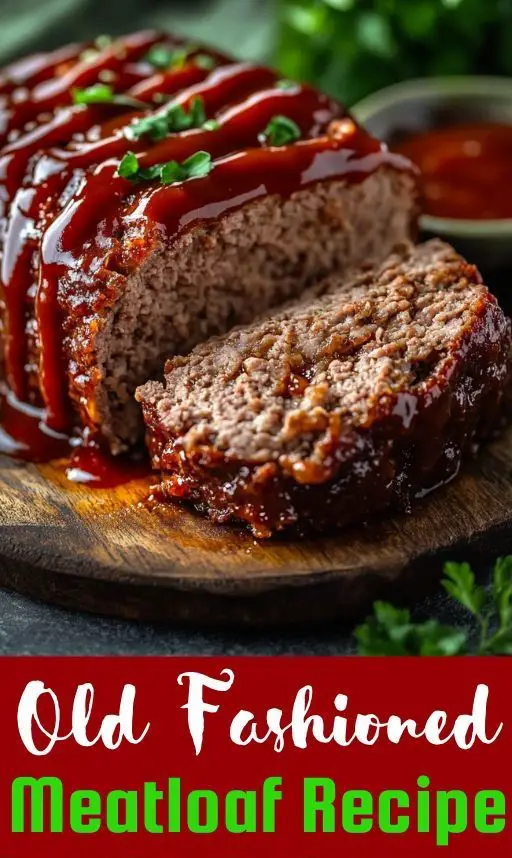This Old-Fashioned Meatloaf recipe brings classic comfort food to your table with ease. Featuring a savory blend of ground beef, breadcrumbs, and aromatic seasonings, it’s topped with a sweet and tangy glaze that caramelizes beautifully in the oven. Whether it’s a weeknight meal or a cozy Sunday dinner, this nostalgic dish delivers hearty satisfaction with every bite.
Ingredients
-
1 ½ pounds ground beef
-
1 cup breadcrumbs
-
1 medium onion, finely chopped
-
2 cloves garlic, minced
-
1 large egg
-
½ cup milk
-
2 tablespoons Worcestershire sauce
-
2 teaspoons salt
-
1 teaspoon black pepper
-
1 teaspoon dried thyme
-
½ cup ketchup (plus an additional ¼ cup for topping)
-
2 tablespoons brown sugar
-
1 tablespoon mustard
Directions
-
Preheat the Oven:
Preheat your oven to 350°F (175°C). -
Combine the Meatloaf Mixture:
In a large mixing bowl, combine the ground beef, breadcrumbs, onion, garlic, egg, milk, Worcestershire sauce, salt, pepper, and thyme. Mix just until everything is evenly incorporated—do not overmix. -
Shape the Meatloaf:
Transfer the mixture into a greased baking dish or a loaf pan lined with parchment paper. Shape it into a firm, even loaf. -
Prepare the Glaze:
In a small bowl, mix ¼ cup ketchup with brown sugar and mustard. Spread this glaze over the top of the meatloaf. -
Bake the Meatloaf:
Bake in the preheated oven for 1 hour, or until the internal temperature reaches 160°F (71°C). -
Let It Rest:
Remove from the oven and allow to rest for 10 minutes before slicing. This helps retain the juices for a moist and tender meatloaf.
Nutritional Information (Per Serving)
-
Calories: 533 kcal
-
Protein: 41 g
-
Fat: 27 g
-
Carbohydrates: 28 g
-
Fiber: 2 g
-
Sugar: 3 g
-
Sodium: 1,172 mg
-
Cholesterol: 117 mg
-
Potassium: 720 mg
-
Vitamin A: 15% DV
-
Vitamin C: 20% DV
-
Calcium: 15% DV
-
Iron: 10% DV
Why Old-Fashioned Meatloaf Remains a Favorite
So, what is it about old-fashioned meatloaf that has helped it maintain such enduring popularity? The answer lies in its perfect balance of taste, texture, and tradition. Here are a few key reasons:
-
Comfort Food at Its Best: Meatloaf is the epitome of comfort food. It’s warm, filling, and familiar, often reminding people of family dinners and childhood memories.
-
Versatility: The base recipe can be easily customized with herbs, spices, vegetables, or different glazes. Some families even incorporate regional or cultural flavors into their version.
-
Affordability: Using ground meat and pantry staples, meatloaf is a budget-friendly meal that can feed a family or be stretched over several days.
-
Leftover Gold: Meatloaf sandwiches are practically a delicacy in their own right. A thick slice of cold meatloaf between two pieces of bread with a little mayo or mustard is a lunchbox favorite.
-
One-Dish Wonder: With just a few steps and a single dish, meatloaf simplifies meal preparation and cleanup, making it ideal for busy weeknights.
The Signature Glaze – A Sweet and Savory Finish
One of the most beloved elements of traditional meatloaf is the iconic glaze—usually a blend of ketchup, brown sugar, and mustard. This caramelizes beautifully in the oven, creating a slightly sticky, tangy-sweet topping that contrasts deliciously with the savory meat.
While some prefer a tomato sauce or gravy topping, the ketchup glaze remains the classic choice for many households. It adds color, moisture, and a burst of flavor that enhances the overall experience.
Tips for the Perfect Meatloaf
Achieving a moist, tender, and flavorful meatloaf doesn’t require culinary wizardry, but there are a few techniques that can make a big difference:
-
Avoid Overmixing: Overworking the meat mixture can result in a dense, tough loaf. Mix until the ingredients are just combined.
-
Use a Binding Agent: Eggs and breadcrumbs not only help hold the meat together but also provide structure and tenderness.
-
Rest Before Slicing: Letting the meatloaf rest for 10 minutes after baking helps the juices redistribute, ensuring a moist final product.
-
Bake on a Sheet Pan: While loaf pans are traditional, baking on a sheet pan allows for more even browning and a greater surface area for glaze.
-
Flavor Enhancers: Worcestershire sauce, garlic, and thyme add depth. You can experiment with additions like grated Parmesan, chopped bell peppers, or even a dash of hot sauce.
Modern Twists and Regional Variations
Though the classic recipe remains beloved, meatloaf has seen numerous variations over the years:
-
Italian-Style Meatloaf: Incorporates Italian herbs, marinara sauce, and mozzarella or Parmesan cheese.
-
BBQ Meatloaf: Uses barbecue sauce instead of ketchup, adding a smoky depth to the glaze.
-
Tex-Mex Meatloaf: Includes ingredients like taco seasoning, salsa, and shredded cheddar for a Southwestern kick.
-
Vegetarian and Vegan Versions: These use lentils, mushrooms, beans, or textured vegetable protein (TVP) to create plant-based alternatives that are still rich in flavor and satisfying.
-
Stuffed Meatloaf: Some versions include a surprise center—cheese, boiled eggs, or sautéed vegetables—adding both taste and visual interest.
Each variation retains the spirit of the original while offering new ways to enjoy this timeless dish.
Serving Suggestions
Old-fashioned meatloaf pairs beautifully with a wide range of side dishes. Classic companions include:
-
Mashed potatoes and gravy
-
Green beans or steamed broccoli
-
Buttered corn or roasted carrots
-
Macaroni and cheese
-
Garden salad or coleslaw
A hearty slice of meatloaf with a comforting side can turn an ordinary evening into a cozy, satisfying meal.
Cultural Significance
In American culture, meatloaf is more than just a recipe—it’s an icon. It represents tradition, resilience, and resourcefulness. It tells a story of families adapting to economic times while finding joy and sustenance in shared meals. Meatloaf also appears frequently in media—from sitcom dinners to memoirs—symbolizing both the ordinary and the extraordinary moments of domestic life.
Storage and Meal Prep Benefits
Meatloaf is an excellent candidate for meal prep. A single loaf can provide multiple servings, and leftovers are just as enjoyable reheated or served cold. It freezes well—both cooked and uncooked—making it a great make-ahead option.
To store:
-
Refrigerate in an airtight container for up to 4 days.
-
Freeze slices or whole loaves for up to 3 months. Thaw overnight in the fridge before reheating.
Reheat in the oven or microwave with a bit of water or extra glaze to retain moisture.
Conclusion
Old-fashioned meatloaf is proof that great meals don’t need to be complicated. It’s a dish born of tradition and practicality, yet it continues to hold a special place in modern kitchens. Whether you’re serving it up for a nostalgic family dinner, preparing it ahead for busy weeks, or reinventing it with your own twist, meatloaf remains a reliable, satisfying, and deeply comforting dish.
By honoring its past while embracing new variations, we ensure that meatloaf stays more than just a recipe—it remains a cherished part of our culinary heritage. So the next time you’re wondering what to make for dinner, consider going back to the basics. With its hearty flavor, simple preparation, and endless adaptability, old-fashioned meatloaf might just become the most reliable comfort food in your recipe collection.






